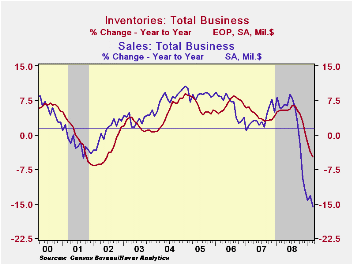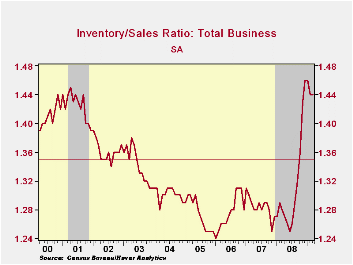 Global| May 13 2009
Global| May 13 2009U.S. Business Inventory Decumulation Intensifies
by:Tom Moeller
|in:Economy in Brief
Summary
Total business inventories fell another 1.0% during March, down for the seventh straight month. These declines have given rise to a three-month decumulation rate of 13.5%. That is the strongest in the series' history which dates back [...]

Total business inventories fell another 1.0% during March, down for the seventh straight month. These declines have given rise to a three-month decumulation rate of 13.5%. That is the strongest in the series' history which dates back to 1980. The recent cutback in inventory accumulation is in reaction to an 11.0% rate of decline in business sales. However, the strong inventory cutbacks have done little to reduce the inventory/sales ratio which, at 1.44, was at its highest level since the recession of 2001. Illustrating the degree of inventory back-up is the increase in the I/S ratio during the last year, which is the swiftest since 1982. The rise ended a twenty-eight year downtrend.
Retailers cut inventories by 0.7% in March and at a 13.2% annual rate during the last three months, nearly the fastest in the series' history. Motor vehicle inventories continued to lead the decumulation and fell at a 30.1% rate during the last three months. Nevertheless, the inventory-to-sales ratio for automobiles remained near its historic high at 2.59. So unless sales recover soon, expect further production cuts.
Outside of autos, retailers continued to reduce the levels of unwanted products. Furniture, home furnishings & electronics inventories fell 0.5% in March and they are off 8.6% during the past year. Apparel retailers ratcheted up the speed of cutbacks with a 1.4% March drawdown. Over the last three months they're down at a 9.7% annual rate, nearly the swiftest on record. General merchandise inventories bucked the trend, however, and rose 0.8% in March but they're still off at a 4.8% rate during the last three months. Despite the cuts the inventory-to-sales ratio for the nonauto retail sector remained high.
The business sales and inventory data are available in Haver's USECON database.
Inventory Accelerator In General Equilibrium from the Federal Reserve Bank of St. Louis can be found here.
| Business Inventories (%) | March | February | January | Y/Y | 2008 | 2007 | 2006 |
|---|---|---|---|---|---|---|---|
| Total | -1.0 | -1.4 | -1.2 | -4.8 | 0.6 | 4.0 | 6.4 |
| Retail | -0.7 | -1.2 | -1.6 | -6.9 | -3.1 | 2.5 | 3.3 |
| Retail excl. Auto | -0.2 | -0.5 | -0.6 | -3.1 | -1.8 | 2.7 | 4.7 |
| Wholesale | -1.6 | -1.7 | -0.9 | -3.5 | 3.1 | 6.2 | 8.2 |
| Manufacturing | -0.8 | -1.3 | -1.1 | -3.8 | 2.1 | 3.7 | 8.2 |
Tom Moeller
AuthorMore in Author Profile »Prior to joining Haver Analytics in 2000, Mr. Moeller worked as the Economist at Chancellor Capital Management from 1985 to 1999. There, he developed comprehensive economic forecasts and interpreted economic data for equity and fixed income portfolio managers. Also at Chancellor, Mr. Moeller worked as an equity analyst and was responsible for researching and rating companies in the economically sensitive automobile and housing industries for investment in Chancellor’s equity portfolio. Prior to joining Chancellor, Mr. Moeller was an Economist at Citibank from 1979 to 1984. He also analyzed pricing behavior in the metals industry for the Council on Wage and Price Stability in Washington, D.C. In 1999, Mr. Moeller received the award for most accurate forecast from the Forecasters' Club of New York. From 1990 to 1992 he was President of the New York Association for Business Economists. Mr. Moeller earned an M.B.A. in Finance from Fordham University, where he graduated in 1987. He holds a Bachelor of Arts in Economics from George Washington University.






